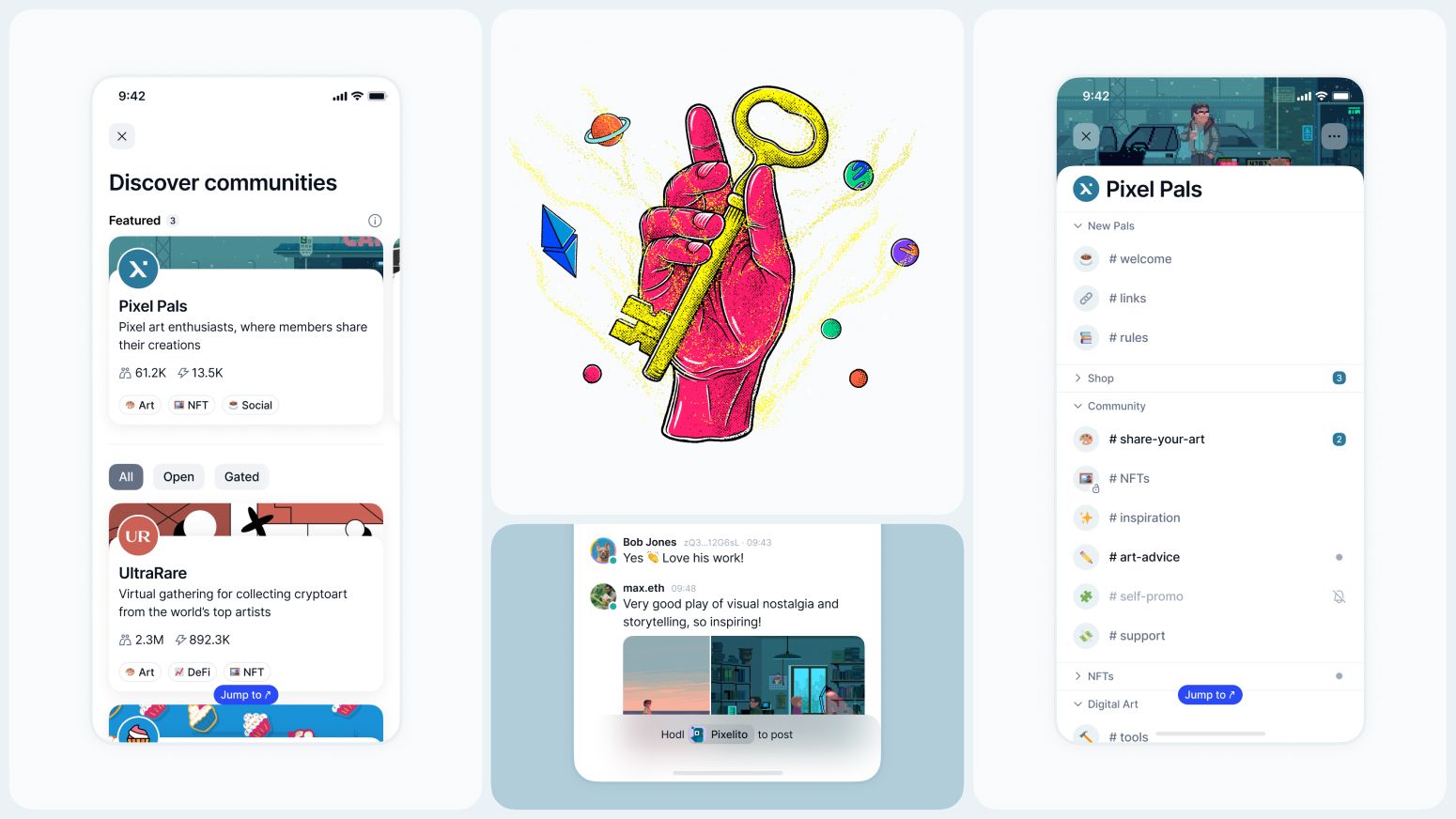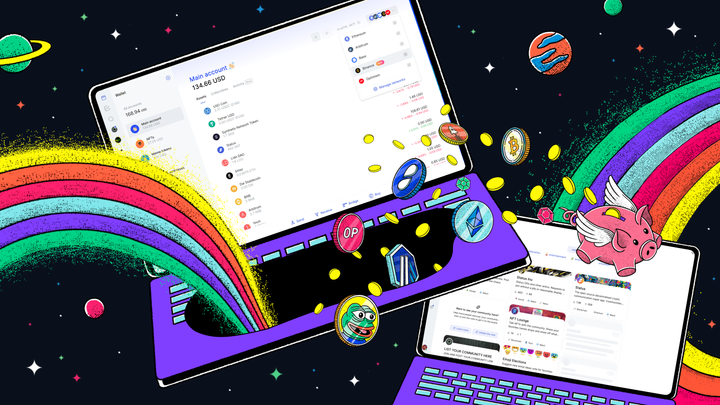As we edge closer to our apps’ relaunch, Status core contributors answered the community’s questions live on X Spaces
We know we’ve been too quiet on the communications front lately. Our only excuse is that we’ve been so busy working on the Status applications ahead of their public alpha and beta releases next year. If you’ve followed Status since the beginning, you’ll know that everything we build aligns with our commitment to maximising user freedoms, even if that requires significantly more engineering effort!
Now that the finish line is in sight, we’re finally ready to share more about what we’ve been creating, why it has taken so long, and what you can expect from the apps at relaunch and further down the line. As part of this effort to reengage the Status community, Status core contributors took your questions during a live AMA held on X Spaces. If you missed it, here’s what we covered!
Principled development: Building alongside beliefs
We began the AMA by reminding the community that everything Status builds is consistent with our mission to bring freedom to the internet — freedom of speech, freedom to transact, freedom to innovate, and freedom to organise. We carry the torch of the original cypherpunk movement, which birthed Bitcoin and Ethereum, and engineer our products to defend civil liberties and empower our users.
This commitment to principled development means we will not take shortcuts for the sake of convenience. One example of many is how we built our Discord community import tool. The easy option would be to store community data on a central server and enable communities to import directly from there. However, that would be vulnerable to capture, censorship, and outages.
The solution we came up with is to store data locally and then convert it into a torrent for community members to automatically seed and leech with each other. It was a lot more engineering effort but is consistent with our mission to maximise freedom through our software.
Introductions out of the way and context set, we dived into the community’s questions!
What happens with the current version of Status on app stores after the app relaunch?
The legacy version of Status is open-source, and open-source software never dies. The current version of Status will continue to function. However, we have spent years ironing out the issues that continue to plague the current app, and the new releases will offer much better performance and functionality. We don’t imagine many folks will still want to use the legacy apps, but they will have the option!
How does Status Messenger compare to the likes of Signal, Telegram or WhatsApp?
Signal is probably the closest of those products to Status Messenger, but it still relies on central servers and fails to protect message metadata. This metadata reveals with who you’re communicating, when you’re communicating, and how often you communicate with them.
The Snowden revelations showed that metadata is extremely valuable to surveillance efforts, and we believe that a surveilled population is not truly free. As such, Status operates over Waku — a family of gossip-based protocols that protect metadata by default. Rather than relay messages only to their intended destination, Waku nodes relay them to all nodes to which they are connected, and only the intended recipient can decrypt their contents. Such an architecture can be extremely bandwidth-intensive, and the Waku team has put in a lot of work to ensure that the protocols don’t consume too much bandwidth as more users send messages through the network.
What is the connection between Logos and Status?
We’re basically sibling organisations. Status is a consumer-facing product, and we develop applications that bring freedom to the internet. Logos builds the hard infrastructure needed to achieve this, including Waku, the decentralised storage engine Codex, and the forthcoming network of blockchains Nomos. These protocols are built as public goods, and anyone is free to adopt them for their DApps, just as Status has.
At its founding, Status aimed to leverage infrastructure developed by others sharing our values. When this infrastructure didn’t materialise, we were forced to pick up the baton and build it ourselves. This spawned Logos and explains why it has taken us as long as it has to get where we are today.
Can we run Ethereum nodes through Status yet?
Very soon! A lot of the work has been done by the Nimbus Ethereum client team, and we plan to integrate the Ethereum main net Nimbus light client into the Status Desktop release early next year. We’re also talking to folks building L2s with a view to integrating similar for different networks in the future.
How will you solve Waku scalability issues?
This is more of a question for the Waku team, and they will be hosting their own X Spaces to share more about their scaling solutions going forward.
However, we can say that Waku aims to scale through sharding. Basically, each Status Community will self-host on a Waku shard. This approach means that a particularly popular Community generating a lot of content will not degrade the performance of other Status Communities.
We’re currently targeting around 10,000 members per Community, but that’s dependent on how frequently people send messages and the size of the messages. This is a great start, but we believe we can push scaling even further by splitting larger Communities across multiple shards.
If you want to learn more about Waku’s scaling journey, check out this blog post.
I’m confused. Is it a redesign or a rebrand?
The recent changes to the Status website reflect our work in redesigning our applications. We’re still Status, but our new domain, design system, and upcoming apps shift the focus away from just instant messaging toward super-app functionality.
Around two years ago, we went back to the drawing board with the vision of combining a multichain wallet, browser, and decentralised communities into a single application. Our app teams adopted a component-first approach for consistency across platforms, and the new website showcases a lot of what’s coming in the relaunched applications.
Yet, the fundamental mission remains — to bring freedom to the world. Status isn’t content to only appeal to the limited blockchain audience but aims to address real-world problems for everyday users. The user experience takes precedence, aspiring not just to match but to surpass leading centralised apps. Overall, the redesign isn’t a mere facelift; it’s a strategic move to simplify the complex world of blockchain for mass adoption.
Head to Status.app and check out the videos and images throughout the new-look site for a glimpse into what’s coming.

What is your strategy for attracting users?
There needs to be a really compelling reason for someone to use an app regularly. We call these killer reasons to use. Here’s an example: If you need to renew your car tax and there’s only one website to do it at, you’ll use it because it offers a service you can’t get elsewhere.
In the group chat space, this means communities and content creators. Imagine a knitting community with a YouTube channel and Instagram, a website, and Patreon. Many knitting enthusiasts follow the community and might pay for some exclusive content on Patreon.
If the content creator running that community decides to start a group chat using Status, many people will likely join — not because they like Status but because they like knitting and have found a community in which they can share their passion. They’ll find themselves inside a community with content they already want to consume and are very likely to be sticky because they have a reason to be there.
This applies to many communities and types of content and shifts the problem of how to get users from “How do we attract individual users?” to “How do we attract content creators and communities?” It’s kind of a marketplace problem. If we get the supply side (the content), then the demand side (the users) will follow.
What we aim to build with Status Communities is the most awesome tool for a content creator or an online community — something that’s free to use while eliminating the risk of the content creator being deplatformed.
While many individual users might not care, content creators and communities are relatively sophisticated users and do care. People spend a lot of time building a business on Patreon, only to be deplatformed, losing their business overnight. We saw similar when Discord shut down the Wall Street Bets server. We have our suspicions but won’t speculate on why this happened. The fact that Discord can arbitrarily turn off its service for a community is a big concern.

How does Status aim to remain affordable for all even as it becomes more widely used?
We’re designing Status to ensure that anybody can download and start using it without a single cent of crypto — it’s entirely free to use.
But there’s always some cost. So, how are our costs borne? Part of it is everybody running Status Desktop will contribute to the various decentralised networks. If a community owner wants to have a Status Community instead of a Discord server, they’ll need some capacity on a Waku store node and a relay node. They can deploy these themselves to their own server or AWS, or we hope there’ll be some third-party node service providers from which they can rent the hardware resources. This cost is borne by the community owner, not the end user.
While there isn’t any cost to the end user for chatting, other token-based costs might arise for those using Status’ non-chat functions. However, we’re supporting many Ethereum L2 chains, which lower the cost of on-chain transactions. You should also check the proposals section of our new forum. Some have proposed a Status app L2, which could help further reduce these costs.
But to summarise, there isn’t that much of a cost to actual chat, and the end user will never bear what little cost there might be.
Is Status using zero-knowledge proofs?
ZK proofs are fascinating and something we’d love to use when we encounter an issue the technology is suited toward. Currently, however, there aren’t many problems we’re working on that require ZK proofs. That said, Waku is working to integrate the network-level spam-prevention mechanism RLN, which uses ZK proofs.
While ZK proofs can certainly enhance privacy, you can have privacy without them, and so far, we haven’t needed to leverage ZK tech. It is also worth pointing out that even in the Nescience zkVM, proposed by Logos research group Vac, you still have information going in and out. As the number of these inputs and outputs increases, it becomes easier to determine what’s going on inside the zkVM. So, ZK proofs should not be thought of as a silver bullet in terms of privacy preservation.
When designing a multichain user experience, what issues have you seen in other products that you would like to solve with Status’s new wallet?
Blockchain scaling issues have encouraged massive L2 innovation, and while L2s mean more people can transact, their proliferation makes for a UX nightmare. To address this, we’ve been working with the standard Gnosis implemented via EIP-3770 and extended it slightly. Instead of prefixing a single chain short name to an address, users can prefix multiple chain short names. This simplifies the multichain experience by enabling users to generate a single address that covers all the chains on which they’re happy to receive funds.
Initially, we want to highlight the work that we’ve done to make transacting across chains more accessible. We’re very proud of the solution we’ve created for one of the multichain experience’s most significant pain points and want users to develop at least a basic understanding of what’s going on. However, we hope it will become such an accepted standard that it just becomes the norm, and we’ll be able to hide it behind the scenes eventually.

Can we send gifs?!
Yes, and lots of them!
Historically, you couldn’t send gifs via Status because they tend to be larger than regular images. Waku used to use proof of work, which meant we had to limit the message size — especially for mobiles.
Waku v2 no longer uses proof of work, and although there is still a message size limit, a recent implementation of message chunking means we will be able to support gifs in a privacy-preserving way. That said, sending gifs currently leaks more metadata than we’d like, so this will be an opt-in feature initially. Once we’ve shipped the relaunched apps, we’ll be working on adding metadata protection for gifs in the same way we do for images and URL unrolls.
How do you balance the trade-offs between user experience, security, and privacy in your design and development process?
We engineer Status to be private by default and make anything that might compromise a user’s privacy in some way explicitly opt-in. Informed consent is very important, so it must be clear to a user when they’re performing an action that might reduce their privacy.
Regarding user experience, we’ve seen projects overabstract aspects of how crypto works away from the user. That works on a simplistic level, but it breaks down when you get into more complex scenarios.
For example, many wallets don’t distinguish between a seed phrase and an account. In reality, there is a difference — your seed phrase generates your private key from which you can derive a number of account addresses. We try to provide at least a basic understanding of what’s going on, including private keys and showing the accounts derived from them in the UI. We want our users to grow and become empowered by the knowledge we share with them.
This encourages them to try more complex things because we haven’t overabstracted how crypto works away from them. They’ve got a foundation of knowledge, which helps them further down the road.
The new Status apps feature account synchronisation between devices. How does Status handle the reconstruction of a seed phrase securely?
We have a rule: We’re never going to pass any private key over a public wire, even if it’s encrypted. When it comes to private keys, you want your paranoia turned up to 11. It’s taken a lot of work to give users a functional multidevice experience without a server, and we’re pretty proud of the solution at which we’ve arrived.
If you add an additional seed phrase or private key to a device, we sync the existence of this private key and its associated accounts between all your devices. Still, we don’t actually send the private key over any wire. When you interact with an account that’s derived from a private key you don’t have on that device for the first time, we let you transfer the private key via a QR code.
The device that has the private key displays a QR of the private key (encrypted with your master key), and this is scanned by the camera of the device that doesn’t yet have the private key. Using photons and optics to transfer it means that all private keys on your devices can be kept in sync in a usable way for ordinary users, without private keys going over any wire. We don’t do any of this in the old legacy versions of Status. It’s just a small part of the new functionality that’s in the new Status apps!
In the future, we’d also like to start digging into social account recovery and other safety features, but we can solve only so many problems at once. We need to get the product into your hands, and then we can focus on these “nice to have” features. We’ve chosen to focus on the multichain problems first, get them to market, and then we will look into account abstraction later.
When and how can we try it?
First of all, everything we do is open-source, so it’s all on GitHub already. There’s nothing to stop anybody from downloading the source code and building it themselves. However, we’re going to be putting out our first public beta of Status Desktop next year, and we’re not recommending anyone use it until this release because until public versions are released, we need to break backwards compatibility.
We’ll let you all know when we think Status Desktop is ready for public consumption, and we’ll also be putting out the official first alpha of Status Mobile. We’ll tell you when it’s ready for you to invest your time into.
The Status Reborn: The Future of Crypto Social YouTube video from about a year ago mentions the Status Switcher. Is that supposed to be something like Google Chrome’s switching tabs?
Fantastic last question! Remember: DApps today aren’t really decentralised. You’ve got a smart contract running on a blockchain and a UI that might be centrally hosted by an entity such as Infura.
We believe in and build according to crypto’s original vision. To achieve applications that are totally decentralised and competitive with those found in web2, you need blockchain for coordination, a messaging network, and decentralised storage. You also might need decentralised computation solutions — something like Truebit.
Ideally, you need these node services running on your local device, and the apps can plug in directly to these locally running p2p nodes. In a perfect world, these would be integrated into operating systems, but that won’t happen any time soon. Consequently, we’re doing the next best thing — building an application that will host these decentralised p2p node services.
Basically, we’re building an operating system within the app so that truly decentralised apps can be used in a totally permissionless way. We need everything you have in an operating system, including a method of switching between apps. The switcher is like an operating system switching mechanism. What we showed in that YouTube video will be in the first version, and we have a lot of cool ideas for how to enhance it later.
One last thing to add regarding user freedom and potential government resistance to it — everything we do is open-source, and you can’t shut down open-source software. Everything is client-side; we don’t run any servers, we just write open-source software. Anybody can take our software, run it, and do what they want. We can’t stop them.
Only the beginning
And that’s a wrap! We hope you enjoyed this summary of our recent AMA. If you have further questions, we’ll host more X Spaces going forward and look forward to answering them live on air.
As you can tell, we’re really proud of the work we’ve done on the new apps and can’t wait to get them to you!






